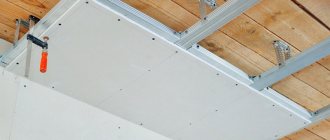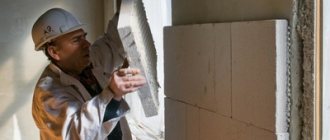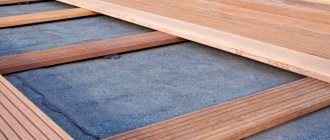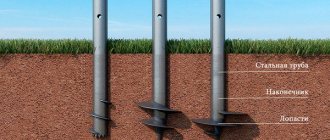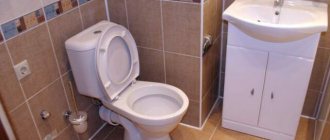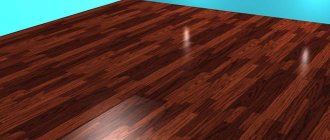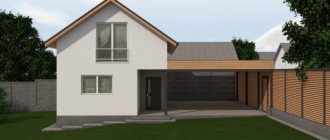Features of painted walls
Wall paint has been used for a long time. For quite a long period, paper wallpaper was used instead for decoration, considering it the best option. However, these judgments are relevant when talking about Russia. And even with the widespread use of wallpaper for a long time, it is impossible to call paint “old and uninteresting” and wallpaper “progressive” materials. The fact is that in the USA and a number of European countries, wallpaper has never been considered particularly chic, and the walls in houses abroad are always painted. And in Russia, despite the emergence of a large number of different finishing materials, paint is now considered interesting and relevant. Looking at the portfolio of any designer, you can see all sorts of finishing options, including painting the walls.
Preparing walls for painting - work order
Why does paint still remain relevant and is used for interior decoration? It's simple - it has too many advantages that you can't turn a blind eye to.
Painting walls in the interior gives room for creativity and imagination
Our people are wary of the idea of using paint instead of wallpaper, although in European countries it is much more common to see painted walls in houses
Table. Advantages of paint as a finishing material.
| Dignity | Characteristic |
| Opportunity to customize the space | You can decorate the walls with paint in any color you want, give them any shade and, as an option, even paint them with paint to order or yourself. Wallpaper involves applying a certain pattern that is already on it. Of course, we are not talking about paintable wallpaper or plain options. But as for the latter, it is the paint that offers much more shades of color. Plus, using colors, you can choose the desired shade yourself. |
| Easy to care for walls | Despite the emergence of washable wallpaper and other materials that can be cleaned using water, paint is still much easier to clean from any contaminants. Also, the paint is almost not destroyed under the influence of a number of cleaning agents, unlike the same wallpaper or some other materials. So for those for whom cleanliness in the house is important, but at the same time children and pets live in the home, paint can be the best solution for wall decoration. |
| Easy to change wall color | Painted walls can be easily repainted in a different color if desired. If we talk about wallpaper, then they will have to be re-glued, and this requires a large number of works. With paint, everything is simpler - you can apply a new color over the old one. |
| Possibility of finishing any surfaces | The paint can be applied to any materials - concrete, wood, drywall, etc. Even a log house can be easily repainted using it in the desired shade. But you can’t put wallpaper on it anymore. |
Wall painting
Of course, paint is far from an ideal material. It also has its drawbacks. So, with frequent exposure to it, it will no longer look neat - it will become worn out, scratched. However, this minus also applies to wallpaper. Also, paint, contrary to popular belief, is far from the cheapest finishing option. Thus, it will require certain preparatory work, which sometimes turns out to be quite costly and troublesome.
What is cheaper - wallpapering or painting the walls?
Important! It is not always recommended to paint walls in a new building. The fact is that a new house is subject to shrinkage, and the paint will quickly become covered with a network of cracks. Typically, painting is done a couple of years after the construction of the structure. For the first time, it is better to put up wallpaper - the resulting defects on the walls will be less noticeable.
In a new building it is better to put up wallpaper first
Dulux - the best matte ceiling paint
Photo: www.profkom64.ru
Approximate price for Dulux Magic White (10 liters): 3100 rubles.
Dulux is the best ceiling paint if you're looking for a matte option (we're talking about products made in the UK, as the company's Russian factories can't always boast the same quality). Its light-absorbing characteristics are so good that they almost completely mask all minor errors in the ceiling surface. The paint has excellent hiding power: just two layers are enough to make the ceiling look perfect. If we add here the low consumption per square meter, environmental friendliness, a wide selection of shades, easy care, the absence of an unpleasant odor and the ability to apply the composition to an unprepared surface, then it becomes clear why the paint is so popular, despite its rather high cost.
Our 9.7 points out of 10
The price is high for this brand, and the quality of Russian-made paint is not stable.
Reviews: “There are no drawbacks except the price. The paint on the ceilings dries very quickly, and within just half an hour there is no smell in the house.”
General information on preparing walls for painting
Preparing walls for painting is a must. Otherwise, you shouldn’t expect a beautiful and neat result. Moreover, the order of work must be strictly observed. Applying the paint itself is sometimes not as difficult as properly preparing the walls, especially those that need leveling and other additional work.
Wall painting technology
Main stages of wall preparation:
- cleaning the walls from old coatings, if any. It is important to remove old wallpaper, peeling paint and other materials that, by their presence under the final coat of paint, can ruin the entire work;
- puttying, which will get rid of all irregularities and minor surface defects. The putty is applied in 1-2 layers, the second is the final one;
- priming makes it possible to ensure a more even application of paint in the future. The primer also increases adhesion and is applied under the putty;
- It may be necessary to treat the walls with antiseptics, anti-fungus, mold, and to prevent other negative consequences.
In each individual case, you need to prepare the walls for painting differently.
Important! Each stage of preparation is performed sequentially; it is important to wait until the layer of one material has completely dried before applying another.
Application technique
The choice of roller coat depends on the chosen paint. The layering technique is also changing. Each paint has its own characteristics. They need to be taken into account in your work.
Water-based paint
The roller coat when working with water-based paint is velor or pile . If you need to paint a small area, then velor is suitable, as it does not absorb paint well. For painting large areas, it is better to use a lint roller. It is more expensive, but it also has advantages:
- layer thickness adjustment;
- uniformity of application;
- tool durability;
- Suitable for rough surfaces.
Enamel
Enamel gives a glossy surface, so the requirements for the initial flatness of surfaces and roller material are higher. The fur coat should not leave streaks, air particles or bubbles behind. The ideal effect can be achieved with a roller made of natural wool, always of a large size. Then the coating turns out smooth, without dried stripes and stains.
Silicate
When applying this paint, the roller must pick up and release the same amount of color with each application. Otherwise, the thickness of the layers and their unevenness will be evident. To apply silicate paint, synthetic rollers and trays with a mesh-shaped rolling area are used.
Are you thinking about painting the walls in your apartment? Read about how to do this in the hallway, living room, bedroom, bathroom and toilet, as well as in the kitchen and dining room.
What tools are needed?
The set of tools required for preparatory work for painting may vary depending on what work needs to be done. However, in general, we can name the main tools that will be needed for these purposes.
Drill with chain attachment
- A drill equipped with a special attachment will allow you to get rid of old plaster.
- Sandpaper with a block or a grinding machine will make it possible to properly level the walls and remove minor irregularities.
- A vacuum cleaner will help get rid of dust generated during the cleaning and sanding of walls.
- To remove old paint, you need to use special compounds, as well as a spatula, a hair dryer and a drill with an attachment made in the form of a metal brush.
- Water in a spray bottle and a wide spatula will help remove old wallpaper.
- Also, for preparatory work you will need a roller or brushes for applying the primer, spatulas that will help apply the putty.
Paint remover
Do not neglect preparing the walls for painting. If this work is not carried out, then the paint will not lie smoothly or will not adhere as firmly as we would like, and will soon peel off.
Styles
Designer decoration of apartments offers dozens of different styles. Among them there are those who will help turn existing disadvantages into advantages.
Rough industrial style does not imply that the walls of the room will be perfectly smooth. Deliberate carelessness of finishing is what is inherent in this direction. The rough structure of concrete or uneven brickwork will look appropriate in such an interior.
Dyeing in dark colors
Ombre technique
This type of coloring has long crossed the threshold of beauty salons. It is even used in clothing design, creating spectacular interiors. Gradation of shades of the same color with a transition from saturated to blurry will help decorate surfaces with flaws.
Painting problem walls without prior leveling is a difficult and exciting task at the same time. After studying the advice of professionals, you need to choose the type of wall covering - wallpaper or special paint. Don’t be afraid to experiment: sometimes a non-trivial approach leads to amazing results , because you can create an attractive and original home interior.
Source
Removing old coatings
First, you should inspect the surfaces that need painting. Depending on the condition they are in, the order of preparation work will depend. If you plan to paint walls that already have finishing, then it is important to first remove all old coatings, as well as all protruding elements that interfere with the work - lighting fixtures, decorative elements, shelves, etc. It is better to remove the furniture from the room if possible, or at least carefully wrap it up into the covering film.
Features of using covering film
Advice! It is better to carry out work on preparing walls using a respirator to avoid inhaling dust.
Old wallpaper is much easier to remove than old paint. Those with a paper backing are the easiest to remove. Sometimes they come off very easily - you just need to pull one edge of the wallpaper sheet. In some cases, the wallpaper may not come off so easily, and then it is better to first moisten it with water, and then, using a spatula, remove it in layers. It is recommended to use warm water for these purposes.
It’s not difficult to remove regular paper wallpaper from walls.
Advice! It is recommended to damage vinyl and non-woven wallpapers well before spraying with water using a serrated roller or a stationery knife. You can also use a steamer to remove them faster.
Whitewash is the most difficult to remove - it must be carefully removed from the entire surface of the walls, and this is not an easy task. If the whitewash is poorly removed, the paint will not lie smoothly. You can remove this material using water, as in the wallpaper method. The simplest option for whitewashing can be simply washed off with plenty of water. In some cases, you will need to use spatulas, sanders and other devices to get rid of the material. They say that the following composition works well for whitewashing: 10 liters of water, 2 tbsp. l. laundry soap, 5 tbsp. l. soda
You can wash off whitewash from walls using a regular sponge and water.
Old paint can be removed using special compounds. Sometimes you don’t have to remove it, but only if the previously applied layer is smooth and without defects.
If you need to remove ceramic tiles, it is important to remove them along with the adhesive that holds them in place. After this, the walls must be carefully leveled to perfect condition. The ceramics themselves can be removed using a hammer drill with a chisel.
Removing old tiles
Elimination of serious defects
After the old coating has been removed from the walls, you can begin further preparation of the walls, that is, puttying and priming. However, if there are serious defects on the walls, such as deep cracks, then it is important to repair them first.
Prices for popular types of putty
Putties
So, any large crack that cannot be filled with a small amount of putty must first be widened and deepened, no matter how strange it may sound. Next, the gap should be thoroughly cleaned of debris and dust and the cavity should be well treated with a primer.
Such places on the wall must be sealed with plaster.
Once the primer layer has dried, you can seal the gap with regular putty. The composition should fill the crack well so that cavities do not form and maximum adhesion of the composition to the surface is achieved. Also, you need to glue a reinforcing tape to the front part of the sealed gap - you need to press it into the layer of putty that has not yet hardened, coat it well with it and then dry the putty and sand it.
Alignment of walls
After large irregularities have been repaired, you can begin to level the entire surface of the walls. If this stage is neglected, then during the final application of paint you will be able to see wall defects that were previously invisible. The walls can be leveled by sanding, plastering or installing plasterboard sheets.
Leveling walls with plasterboard
Grinding is used to level concrete walls and prepare them for painting. The main thing is that the surface itself is durable and does not crumble, and also does not have serious defects. You can sand with a special machine or even sandpaper. This procedure will remove all minor defects and irregularities.
Wall and ceiling sander Aspro-C3 (no vacuum cleaner required)
Prices for sanding machines for walls and ceilings
Sanding machine for walls and ceilings
You can also use stripping and plastering to remove small defects. After completion of work, level differences on the wall should not be more than 2 mm per 1 linear meter. If everything is good, then you can start plastering and priming.
Plastering allows you to get a perfectly smooth wall surface. The composition must be applied in such quantity that it is sufficient to completely level the walls. Thus, thick layers of plaster can be applied along the beacons - this is how concrete walls are usually prepared. Before applying the putty, the walls must be primed to increase adhesion. The primer layer takes several hours to dry.
Plastering a wall
Important! The layer of plaster cannot be made more than 3 cm. If it is planned to be thicker, then you will have to lay a reinforcing mesh, which, by the way, must be laid if you plan to paint brick walls.
After plastering, it is important to apply a thin finishing layer of putty to the walls. Only after it has dried can you proceed directly to priming and painting the walls. Before applying the finishing layer, the starting layer of putty also needs to be sanded, just like the walls. The main thing is not to get carried away and sand off the entire finishing layer. It is better to remove the resulting dust with a dry cloth so as not to spoil the putty layer. After applying the putty, the wall must be primed again.
Primer for walls
Prices for deep penetration primer
Deep penetration primer
“Snezhka” – the best quality in the inexpensive segment
Approximate price for SNIEZKA EKO paint (10 liters): 1400 rubles.
Ceiling paint pleasantly surprises with the best price/quality ratio. Suitable for almost any type of surface, has excellent hiding power. Allows you to ideally combine surfaces of different textures, which is often necessary when installing plasterboard on the ceiling.
Almost all options are not very resistant to water, but are hypoallergenic and environmentally friendly. The paints are easily tinted to the user's desired shade. Unfortunately, the paint consumption indicated by the manufacturer differs almost twice from the actual one, for which “Snezhka” receives a big minus from us.
Reviews: “I was pleasantly surprised by the coverage, the paint really applies to the ceiling very evenly and in one pass you get a very high-quality white coating.”
"Expert" - excellent white paint for ceilings
Approximate price for “Expert Washable” (14 kg): 850 rubles.
Expert paints are one of the lines of paint and varnish materials from DEKART. After applying products from this brand, ceilings look truly white. It is for its pure and bright color that the paint is valued by finishing craftsmen. “Expert” ceiling paints have a range of advantages:
- dry quickly;
- do not lose color over time, do not crumble or wear off;
- have no odor after drying;
- non-toxic;
- look great in glossy and matte finishes;
- suitable for all types of surfaces.
The process of preparing walls for painting
Step 1. The first step is to inspect the surface of the walls that you plan to paint and assess its condition. This procedure will help you understand what work will need to be done to prepare the walls.
First the walls are inspected
Step 2. Using a spatula, you can remove some of the debris from the wall, including pieces of cement.
Everything unnecessary is removed
Step 3. Using a rule or a straight line, you need to evaluate the evenness of the wall. The rule needs to be applied to the wall and see if there is a gap between it and the wall, which will indicate the unevenness of the wall. It is especially important to check the corners carefully.
The rule is applied to the wall
Step 4. All large irregularities, especially in the corners, can be knocked down with a hammer drill.
Irregularities are removed using a hammer drill
Step 5. Next you need to apply the primer using a regular roller. You can also use a brush, but the work in this case will take longer.
Applying primer
Step 6. Now you can use plaster to tighten the corners and seal large irregularities with it.
The corners are tightened with plaster
Step 7. After applying the putty in the area of the corners, it needs to be stretched using the rule.
The mixture is stretched by the rule
The result of the work done
Step 8. Now it is recommended to glue corner-forming tape in the corners, which will allow you to beautifully form the corners in the room and prevent the corners from cracking in this place. Gluing it is simple - you need to apply putty to both sides of the corner of the room, then take a piece of tape, bend it in the middle and paste it into the corner.
Angle forming tape
Forming corners indoors
Step 9. Next, running a spatula along the tape, you need to remove all excess putty.
Excess putty is removed
This is what the formed angle looks like
Step 10. Now you need to mix the finishing putty according to the instructions.
Finishing putty is mixed
Construction mixer price
Construction mixer
Step 11. The finished putty must be applied to the entire surface of the walls in one even layer.
The putty is applied in an even layer
Another photo of the process
Step 12. After the first layer of putty has dried, before applying the second, you need to remove with a clean spatula the small tubercles that formed when the first layer of putty was applied.
Use a clean spatula to remove small bumps
Step 13. Now you can apply the second layer of putty. It is important to illuminate the wall from the side - this measure will allow you to see whether the layer is applied evenly. Application is also done with a spatula.
Wall lighting
The second layer is applied
Step 14. When the second layer of putty has dried, you need to sand the surface well using fine-grain sandpaper.
Sanding a wall with sandpaper
Step 15. Now you should prime the walls again. The primer can also be applied by roller or spray.
The primer is applied with a spray gun
Step 16. Next you need to glue the fiberglass. It is glued using an airless painting machine. It can also be glued with a roller. First, the adhesive is applied, then the fiberglass itself is glued and leveled with a spatula. It is important to glue fiberglass using glue with dye. Then, when applying the last layer of putty, it will be clear whether it has been applied in a sufficient layer.
First, the adhesive is applied
Next, the fiberglass itself is glued
Step 17. After the layer of fiberglass has dried, you can apply the so-called superfinish putty, which has a very fine fraction.
Superfinish putty is applied
Step 18. Superfinish putty is also applied under lighting from the side. It must be applied after the previous layer has dried.
The wall also needs to be lit from the side
Step 19. The final stage is sanding the wall with all layers with fine sandpaper. The wall is ready for painting.
At the end the wall is sanded again

